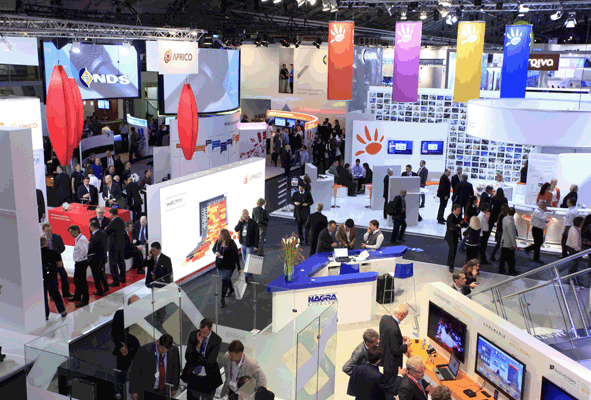It's All About Content Delivery at IBC 2011
by Virgil Labrador, Editor-in-Chief
Amsterdam, September 15, 2011—This is not your father’s IBC. Like most industry shows, the IBC is evolving and it’s getting harder to distinguish traditionally broadcast-oriented shows like the IBC in Amsterdam and the NAB in Las Vegas with the Consumer Electronic Show (CES) and other shows dealing with content delivery and management.
If you’re still not convinced that the industry is changing, this year’s IBC featured as keynote speaker, Facebook’s EMEA Managing Director, Joanna Shields who assured the attendees in her speech that “we will not go into the content business,” Hmm, where have we heard that before?
The discussions at IBC dealt with, among others, the growing Over-the-Top (OTT) services that are gaining in popularity. IMS Research forecasts that in 2016, OTT video services will generate $16.4 billion in 2016 and video-on-demand (VOD) services from pay-TV operators will generate another $14.7 billion, for a combined $31.1 billion in on-demand revenues.
 OTT services and products were in display at the “Connected World” section of the IBC which occupied the largest hall in Hall 13. The Connected World included the Mobile and IPTV zones which featured new technologies driving the revolution in the creation, distribution & consumption of video/multimedia content via internet-connected devices and the connected home of the future. Among the exhibitors at Connected World included providers of set-top boxes, hybrid TVs, LCDs, netbooks, games consoles, tablets, media players, mobile phones and other consumer devices.
OTT services and products were in display at the “Connected World” section of the IBC which occupied the largest hall in Hall 13. The Connected World included the Mobile and IPTV zones which featured new technologies driving the revolution in the creation, distribution & consumption of video/multimedia content via internet-connected devices and the connected home of the future. Among the exhibitors at Connected World included providers of set-top boxes, hybrid TVs, LCDs, netbooks, games consoles, tablets, media players, mobile phones and other consumer devices.
One thing that not so hot this year at IBC is 3D. In contrast to the past years where 3D was the highlight of the exhibition, one thing very noticeable this year is the lack of 3D screens in the exhibition floor. Director James Cameron , who screen his 3D blockbuster, Avatar, here at the IBC two years ago, is back again this year but he’s not as bullish as to the prospects of 3D this time. Cameron said that there’s just not enough 3D content around to justify people buying 3D sets. There’s a need for more content like sports, live events, etc. , according to Cameron.
There is some 3D demos at the IBC, like the BBC previewing some of its capabilities for the Summer Olympics to be held in London next year. But that’s about it.
Satellite service providers are adopting to the new multimedia environment and repositioning themselves as “content delivery providers.” The new mantra seems to be “we can take any signal, in any format and deliver it to any media.”
One such company is Israel-based satellite service provider, Satlink Communications. Satlink, which operates teleports, is positioning itself in providing “Content Delivery Networks” (CDN). “the requirements of customers have changed over the years. It is no longer sufficient to just provide traditional uplink and downlink services. Now it is essential to provide a true end-to-end service that can deliver content from different formats to different distribution channels,” said Satlink CEO David Hochner. Listen to a podcast of the interview at www.satellitemarkets.com/current/?q=node/98
“Content is king, but interface is the crown,” said Bill Roedy of MTV Networks said in the session on the “Future of Broadcasting.” Consequently we see a lot of interface equipment on display at the show. The buzzwords are “interoperability” and “multiplatform delivery.”
The following are some key trends that I observed from visiting several equipment manufacturers at IBC:
Ka-Band. Several new Ka-Band satellites like Eutelsat’s KA-SAT, Avanti’s Hylas-1, Yahsat-1, among others have been launched recently in the EMEA region and many more are planned. This makes Ka-Band ground equipment in great demand.
Bandwidth Optimization. Equipment that optimizes bandwidth and use scarce spectrum efficiently are very hot. With rising transponder prices and growing demand from users, bandwidth optimization products can save customers a lot.
Carrier ID. Satellite interference is a major issue with incidences on the rise globally. At IBC, Eutelsat announced that it will be requiring all its users to have carried id capability which helps in identify sources of interference. Industry groups like the GVF and sIRG are hoping other operators will follow suit, which it hopes will lead to the standardization of Carrier ID capability in uplink equipment.
Ground equipment are also getting smaller as space becomes a premium for teleports and service providers.
Finally, attendance this year is up 4% percent from last year at the IBC, so the show continues to be relevant not just for the EMEA region but for others as well.
To view videos of interviews with key industry executives at the IBC 2011 click here.
--------------------------------------------------
 Virgil Labrador is the Editor-in-Chief of Los Angeles, California-based Satellite Markets and Research which publishes a web portal on the satellite industry, the monthly Satellite Executive Briefing and occasional industry reports calledMarketBriefs. Virgil is one of the few trade journalist who has worked in the industry as a senior executive for a teleport in Singapore , the Asia Broadcast Center, then-owned by the US broadcasting company CBS. He has co-authored two books on history of satellite communications and satellite technology. He holds a Master’s in Communications Management from the University of Southern California (USC). He can be reached at virgil@satellitemarkets.com
Virgil Labrador is the Editor-in-Chief of Los Angeles, California-based Satellite Markets and Research which publishes a web portal on the satellite industry, the monthly Satellite Executive Briefing and occasional industry reports calledMarketBriefs. Virgil is one of the few trade journalist who has worked in the industry as a senior executive for a teleport in Singapore , the Asia Broadcast Center, then-owned by the US broadcasting company CBS. He has co-authored two books on history of satellite communications and satellite technology. He holds a Master’s in Communications Management from the University of Southern California (USC). He can be reached at virgil@satellitemarkets.com





